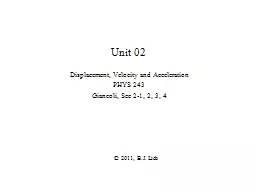

PHYS 243 Giancoli Sec 21 2 3 4 2011 BJ Lieb Analysis of a Race All distances measured from starting line Time measured by a stopwatch from sound of gun Initial speed will be zero ID: 647761
Download Presentation The PPT/PDF document "Unit 02 Displacement, Velocity and Accel..." is the property of its rightful owner. Permission is granted to download and print the materials on this web site for personal, non-commercial use only, and to display it on your personal computer provided you do not modify the materials and that you retain all copyright notices contained in the materials. By downloading content from our website, you accept the terms of this agreement.
Slide1
Unit 02
Displacement, Velocity and Acceleration PHYS 243Giancoli, Sec 2-1, 2, 3, 4
©
2011,
B.J.
LiebSlide2
Analysis of a Race
All distances measured from starting line.
Time measured by a stopwatch from sound of gun.
Initial speed will be zero.
Each runner’s motion will be described by different equations.Motion is limited to one dimension by the lanes (if a short race on a straight track).
Unit 2 - 2Slide3
Coordinate System
We will use a set of coordinate axis where x is horizontal and y is vertical.If the motion is on the surface of the earth then x might be the east/west axis and
y
the north/south axis.
In a 3-dimensional problem z is the third axis and it is directed out of the page
+
y
-y
+
x
-x
Unit 2 - 3Slide4
Displacement
Displacement:
change in position
+
y
-y
+
x
-x
x
1
x
2
Displacement is a vector, so it has magnitude and direction. In one dimension we use + or minus sign to indicate direction.
Unit 2 - 4
Final - InitialSlide5
Don’t Confuse Displacement and Distance
A person walks 70 m East and 30 m West.
Distance traveled =
Displacement =
100
m
40
m East
or + 40 m
Unit 2 - 5Slide6
Negative Displacement
Jane walks from
x
1
= 40 m to x2 = 20 m. The displacement is:
A negative displacement may indicate motion toward the West or something else depending on the situation and the coordinate system chosen.
20 30 40 50
Distance (
m)
Unit 2 - 6Slide7
Displacement is a Vector
A vector is a quantity with magnitude and direction.
In 1-D motion, the sign indicates the direction.
The magnitude of Jane’s displacement is 20
m. The direction is negative which may indicate to the left or the west, etc. depending on the coordinate system. The red arrow is a graphical representation of the vector.
20 30 40 50
Distance (
m)
Unit 2 - 7Slide8
Average Speed and Velocity
Average velocity is a vector, so it has magnitude and direction. In one dimension we use + or minus sign to indicate direction.
Unit 2 - 08Slide9
Instantaneous Velocity
instantaneous velocity
is defined as
the average velocity over an infinitesimally short time interval.
Unit 2-09
When you are driving, the speedometer reading is the
i
nstantaneous speed which when combined with the direction gives the instantaneous velocity.
The average velocity is the total distance over the total time.Slide10
Acceleration
Average Acceleration:
change in velocity divided by the time taken to make this change.
Unit 2 - 10Slide11
Acceleration
Instantaneous Acceleration:
same definition as before but over a very short
time interval
t.
Unit 2 - 11Slide12
Example
2-1.
A car travels at constant speed for 95.0
m
for 5.00 seconds. The driver then applies the brakes and the car stops in 6.00 seconds. What is the car’s average acceleration during the time it is breaking? (Assume the car travels in a straight line directly north).This is a two part problem. In the first part, we use the first 5.00 seconds to find the velocity. Since the car travels in a straight line, this is one dimensional motion and the speed is the magnitude of the velocity.
The second part, in 5.00 seconds, the velocity of the car changes from 19.0
m/s
to zero.
The + sign indicates that the velocity is directed to the north.
The + sign indicates that the velocity is directed to the north
.
Unit 2 - 12Slide13
Example
2-2
.
A car traveling at 15.0 m/s slows down to 5.0 m/s in 5.0 seconds. Calculate the car’s acceleration.
Coordinate System: + is to the right
Unit 2 - 13
The negative answer indicates that the acceleration is to the left, not that it is deceleration. It is a case of deceleration but we know that because the acceleration is in the opposite direction from the velocity..
For example, suppose the car were moving to the left in this coordinate system. Then the acceleration would be positive, but it would still be deceleration.Slide14
Unit 2
AppendixUnit 02- 14Photo and Clip Art Credits
Some figures electronically reproduced by permission of Pearson Education, Inc., Upper Saddle River, New Jersey
Giancoli, PHYSICS,6/E © 2004. Slide 2-02 Runners: Microsoft Clipart Collection, reproduced under general license for educational purposes.2-05 Drawing: Copyright © Pearson Prentice Hall, Inc, reproduced with permission
2-06 Clipart: Microsoft Clipart Collection, reproduced under general license for educational purposes
.
2-07
Clipart:
Microsoft Clipart Collection, reproduced under general license for educational purposes.
2
-13 Drawing:
Copyright © Pearson Prentice Hall,
Inc, reproduced with permission